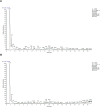Gui-Pi-Tang Defers Skeletal Muscle and Cardiac Muscle Aging by Promoting Mitochondrial Remodeling
- PMID: 40291160
- PMCID: PMC12024472
- DOI: 10.2147/DDDT.S509046
Gui-Pi-Tang Defers Skeletal Muscle and Cardiac Muscle Aging by Promoting Mitochondrial Remodeling
Abstract
Purpose: To determine whether Gui-Pi-Tang (GPT) has protective effects on skeletal muscle and cardiac muscle in aged mice.
Methods: This study used C57BL6/J mice to establish an in vivo natural aging model, while D-galactose (D-gal)-injured C2C12 and H9c2 cells were employed to create in vitro aging cell models. Hematoxylin and eosin (H&E) staining was used to assess the effect of GPT on skeletal and cardiac muscle in aged mice. Protection against age-induced cellular damage by GPT was assessed in C2C12 and H9c2 cells using β-galactosidase staining. Mitochondrial morphology, structure, and function were analyzed using transmission electron microscopy, Seahorse assays, and ATP content measurements. Potential mechanisms by which GPT regulates mitochondrial homeostasis were examined using Western blot analysis.
Results: GPT treatment significantly improved the alignment of skeletal muscle fibers, reduced gaps, and increased the cross-sectional area (CSA) of skeletal muscle in aged mice. It also reduced the CSA of cardiac muscle fibers, alleviating cardiomyocyte hypertrophy. Mitochondrial morphology was restored, and GPT reduced D-gal-induced β-galactosidase elevation. Furthermore, GPT protected mitochondrial morphological and structural integrity in the skeletal and cardiac muscles of aged mice and improved mitochondrial respiratory function and ATP levels in D-gal-injured C2C12 and H9c2 cells. GPT treatment increased the levels of mitochondrion-associated proteins PGC-1α, PPARγ, Nrf1, and OPA1 in the skeletal and cardiac muscle of aged mice. Moreover, GPT modulated Drp1 expression, with increases in aged skeletal muscle and decreases in aged cardiac muscle.
Conclusion: These findings suggest that GPT helps maintain mitochondrial homeostasis by regulating mitochondrial remodeling, thereby alleviating skeletal and cardiac muscle damage in aged mice.
Keywords: Gui-Pi-Tang; mitochondrial homeostasis; myocardium; senescence; skeletal muscle.
© 2025 Cai et al.
Conflict of interest statement
The authors report no conflicts of interest in this work.
Figures









References
-
- de Oliveira Zanuso B, de Oliveira Dos Santos AR, Miola VFB, Guissoni Campos LM, Spilla CSG, Barbalho SM. Panax ginseng and aging related disorders: a systematic review (1873-6815 (Electronic)). Exper Gerontol. 2022;161:111731. - PubMed
MeSH terms
Substances
LinkOut - more resources
Full Text Sources
Medical
Research Materials
Miscellaneous

